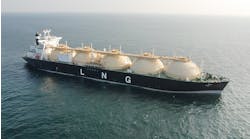Martin Kelly
Wood Mackenzie
The UK relies on continued capital investment in its mature fields to stave off production decline. The current economic crisis, in conjunction with lower oil prices, affects this capital investment, and has shaken confidence in the industry. Since the end of last year, Wood Mackenzie has reduced its forecast of 2009 UK capital expenditure by 25%. Based on our most recent field analysis and evidence from the last major drop in oil price, we estimate the near-term decline rate for liquids will increase from 5% to 10-15%.
Many companies already have reduced in- vestment in the North Sea, as the drop in oil price puts pressure on revenues, margins, and spending plans. Furthermore, tight credit markets have limited the ability of smaller companies to raise capital. As a result, some companies struggle to maintain investment levels, and in a few cases, companies have entered administration or been forced into a distressed sale (both corporate and asset).
Given the maturity of the UK North Sea oil fields, those fields rely heavily on continued capital investment to limit production decline. Any reduction in capital spend is likely to boost decline rates, which will prove difficult to reverse on these old fields that underpin UK production. Liquids production decline is unlikely to be offset significantly by new developments coming onstream, as the larger fields under development or expected to be developed are predominantly gas.
Late 1990s comparison
In late 1997, the oil price peaked at over $20/bbl. Twelve months later, the oil price was less than $10/bbl, the sharpest drop since the end of the Gulf War in 1991. That decline both preceded and encouraged the series of major corporate acquisitions that dominated the headlines. In addition to these deals, however, there was an impact on investment in the industry across the globe.
The chart above shows the overall capital spend and drilling spend in the UK since the mid-1990s (excluding the impact of new fields brought onstream), as well as the year-on-year change in decline rates.
During the late 1990s, there was a more marked drop in overall capital spend than there was in drilling spend, as companies strove to maintain production-generating investments. However, the decision to invest in maximizing near-term reserves came at the expense of maintenance and routine equipment replacement. This benefited companies in the short term, but we believe these strategic decisions are partly responsible for the major investment in maintenance projects made in recent years.
Despite the efforts to protect drilling activity, a 30% drop in capital spending from 1996 - 1999 resulted in an increase in decline rates from 2% per annum to 15%. Any change in decline rates lags investment by around 12 months, as yearly planning cycles leave less scope for immediate adjustments to plans, particularly within larger companies. In addition, service sector costs respond more slowly than operators to a change in oil price. Consequently, operators cut activity rather than continue with current plans at costs now out of kilter with the oil price. This was evident back in the late 1990s, and is seen again currently, with operators anticipating a decrease in costs that have not yet been realized.
Decline rates slowing down
Despite an alarming increase in decline rates through the late 1990s, there has been a recent turnaround in performance. When compared to the years between 1999 and 2003, the rate of decline over the past five years has slowed considerably, from 15% to less than 6%. The high oil price and the concession regime in the UK made it an attractive place to invest, so companies continued to develop fields. Developments where this has been particularly noticeable include Forties, Beryl, Magnus, and Ninian, as high levels of drilling have kept production flat and were forecast to continue to do so.
The charts on the previous page show field-by-field decline rates over the last five years and those expected for the next five years from our models three months ago. Despite the fields getting older, decline rates were expected to increase only slightly from 5% to 6% in the coming five years.
However, we now see examples of investment cuts and many fields will not achieve these forecasts, particularly fields with fixed platforms. For example, drilling on one such field has been halved with only five wells now planned. The knock on effect is a drop in our 2010 production forecast of 15%.
Impact on liquids’ production
The scale of the increase in decline rates across UK fields and how long it lasts depend on a number of factors. However, based on the evidence from 10 years ago, and an estimated drop in investment this year of around 25%, we forecast a decline rate over the next two years averaging 10 - 15%, up from around 5% in 2008. This could mean a 160,000 b/d reduction in overall 2012 production, from 1,445,000 b/d to 1,285,000 b/d.
The sampled fields in the chart on the previous page are those analyzed as part of this insight that have produced throughout the period 1995-2008. The remaining fields onstream are those that came online during the period analyzed; they have been excluded as they distort year-on-year decline rates significantly. Both the under development fields and probable developments are fields that we expect to come onstream in the near term. The decline rates of these future developments have not been adjusted, as we assume they will be unaffected by a drop in investment. Although our timescales for these projects take the current environment into account, there is still a risk of further delays.
The charts on the previous page include only currently commercial fields. In future years, fields currently classed as technical reserves will be brought onstream and slow the overall decline rate. Similarly, yet-to-find reserves will enhance UK liquids production in the longer term. However, exploration and appraisal drilling has dropped already and this will impact the production contribution of future discoveries. The number of wells drilled this year is down by half compared to the same time last year, and the number of discoveries is down from 10 to four. There is no evidence of a substantial pick-up during the remainder of the year.
Despite the less optimistic outlook, there are a number of factors that could ensure the drop in liquids production will not be as severe. There already is evidence that operators are working with suppliers, and costs across the industry are expected to fall. Consequently, there will be a point where companies are happy to continue or even ramp up investment again, with the resultant upturn in new production coming onstream.
A recovery in oil price also would help maintain investment in the North Sea. There have been some signs in the past few months that this is happening, with a barrel of Brent crude touching $70. However, we do expect companies to remain conservative with pricing assumptions, at least until oil prices are sustained at higher levels.
Furthermore, the recent changes in the fiscal terms announced in the UK government’s budget in April aim to stimulate investment in new developments. The value allowance for small fields, ultra HP/HT, and heavy oil fields is expected to encourage companies to reconsider discoveries that were previously marginal or uneconomic. But we believe other factors including tight credit markets mean the short-term impact will be limited. If the oil price continues to recover and the access to capital for smaller companies improves, then we could see more developments moving forward.
If 2009 proves to be the only year in which investment drops significantly, then we expect the industry would cope and recover. However, if the drop is sustained, then in our view the impact will be hard to repair. Following the reduction in investment in the 1990s and then the subsequent increase, it took a number of years before decline rates were stemmed. Since then, the basin and many of its producing fields and platforms have aged a further 10 years. The challenges in turning things around once again will be even harder. Therefore, the upcoming planning cycle for 2010 and beyond will go a long way to determine how much production and ultimately, recoverable reserves, will be affected by the recession and the financial crisis.
Editor’s note:Wood Mackenzie has analyzed the impact of reducing capital investment on decline rates for over 100 liquids-producing fields onstream throughout 1995 to 2008. Fields that produced associated liquids were excluded. The year-on-year decline rate is the change in production for that year relative to the previous year’s production. The overall capital spend excludes any E&A drilling and abandonment costs. The capital spend is in £, nominal terms.





